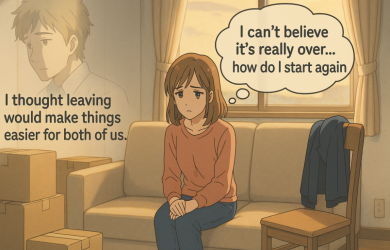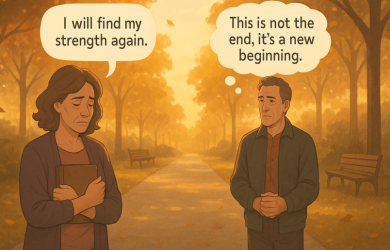How to Heal From a Divorce You Didn’t Want: 7 Tips

Unlock Daily 30-Sec Tips for a Happier Relationship
👉 Subscribe FREEKey Takeaways
Marriage.com AI Quick Summary
A divorce can be a challenging and emotionally draining experience, but the pain can be even more profound when it happens unexpectedly. However, despite the heartbreak, finding healing and moving toward a brighter tomorrow is possible.
In this article, we will explore powerful tips to help you how to heal from a divorce you didn’t want. By implementing these tips, you can begin the divorce recovery journey and reclaim your life with renewed strength and resilience.
Understanding the emotional impact of an unwanted divorce
A divorce you didn’t want can leave you grappling with intense emotions. In their article, Sbarra and others say feelings of shock, disbelief, anger, sadness, and even betrayal may overwhelm you during this time.
Recognizing that these emotions are a natural response to an unexpected end can help you navigate the path to recovery from divorce. Healing after divorce is a journey that requires self-compassion and patience. It’s important to give yourself permission to grieve and process the loss.
In the following sections, we will explore practical tips on how to get over a divorce you don’t want and reclaim your life during the divorce recovery process.
7 tips for healing from a divorce you didn’t want
When facing the challenging journey of divorce recovery, particularly after a divorce you didn’t want, it’s crucial to equip yourself with practical strategies for healing and moving forward. Here are seven essential tips to guide you through the process of how to heal from a divorce you didn’t want:
1. Allow yourself to grieve and process the loss
Give yourself permission to experience and express your emotions. It’s normal to feel a range of emotions, such as sadness, anger, and confusion.
According to Grady Shumway, LMHC:
Healing isn’t linear; some days will hurt more than others, and that’s okay. The important thing is giving yourself grace as you navigate forward.
Take the time to mourn the loss of your marriage and acknowledge that healing after divorce is a process that requires self-compassion and patience (Leopold, 2018)
2. Seek support
How to get through a divorce you don’t want?
Reach out to trusted friends, family members, or support groups who can provide a listening ear and understanding. Seek therapy or counseling if needed to help reframe negative thought patterns
3. Focus on self-care
Take care of your physical, emotional, and mental well-being. Engage in activities that bring you joy and provide a sense of fulfillment. Explore mindfulness practices, meditation, or journaling to help process your thoughts and emotions.
4. Set boundaries and establish a new routine
During the divorce recovery process, setting boundaries with your ex-spouse and establishing a new routine for yourself is essential. Determine what is necessary for your well-being and communicate your needs.
5. Embrace positive coping mechanisms
Instead of resorting to destructive coping mechanisms like excessive alcohol consumption or isolating yourself, focus on healthy alternatives, Reiter and others said in their article.
They further advise engaging in activities that bring you peace and fulfillment, such as hobbies, exercising, spending time in nature, or pursuing creative outlets, aiding your healing and helping you move on after divorce.
Grady Shumway highlights that:
Coping well doesn’t mean pretending everything’s fine; it means choosing small, nurturing steps that remind you that life can still hold beauty, even in the midst of pain.
6. Challenge negative thoughts
How to learn ways of coping with a divorce when you don’t want it?
Divorce can bring about a flood of negative thoughts and self-doubt. Counteract these harmful patterns by challenging them with self-compassion and self-affirmation. Remind yourself of your strengths, resilience, and the potential for a brighter future.
7. Embrace the future
While it may be challenging to see beyond the pain, embracing the possibilities ahead is essential. Allow yourself to dream, set new goals, and envision a fulfilling future. Take small steps toward rebuilding your life and focus on personal growth.
How to heal from a divorce you didn’t want?
Remember, healing and recovery from divorce take time. Be patient with yourself and celebrate even the most minor victories along the way. By implementing these tips and staying committed to your well-being, you can gradually heal, move forward, and find happiness after a divorce you didn’t want.
Some commonly asked questions
Here, we address some common questions people often ask about healing from a divorce you didn’t want. We hope this information helps you with additional or needed information.
-
How do I accept that my marriage is over?
Accepting the end of a marriage is a complex and painful process. Start by allowing yourself to feel and grieve the loss. Seek support from loved ones or professional counselors to help you navigate through this challenging time.
Focus on self-care, explore new interests, and gradually embrace the idea that moving on is necessary for personal growth and happiness.
Watch this video to learn how to accept your divorce:
-
What are the five stages of divorce?
The five stages of divorce, as identified by researcher Elisabeth Kübler-Ross, are:
- Denial: Initially, there may be disbelief or denial about the impending divorce.
- Anger: Anger and resentment can arise as emotions are processed and the reality of the divorce sets in.
- Bargaining: Individuals may attempt to negotiate or find ways to salvage the marriage.
- Depression: Feelings of sadness, loss, and despair may emerge as the divorce becomes final.
- Acceptance: Accepting the divorce and the new reality can lead to healing and moving forward.
-
Will the pain of divorce ever go away?
The pain of divorce may not completely disappear, but it can diminish over time. Healing and moving on after divorce is a gradual process.
With self-care and professional help, individuals can learn to cope with the pain, gain resilience, and find new sources of happiness and fulfillment. Each person’s journey is unique; finding acceptance and peace is possible.
Final takeaway
Healing from a divorce you didn’t want is a challenging journey that requires time, self-compassion, and support. While the pain may not completely vanish, it can diminish as you invest in your well-being and embrace the opportunity for personal growth.
By acknowledging and processing your emotions, seeking support, practicing self-care, and envisioning a positive future, you can navigate the path of divorce recovery. Remember, healing is possible, and you have the strength to rebuild your life and find happiness after a divorce you didn’t want.
 Tips
Tips
Write your tip or submit a video tip
All tips are reviewed before the publishing.
Share this article on
Want to have a happier, healthier marriage?
If you feel disconnected or frustrated about the state of your marriage but want to avoid separation and/or divorce, the marriage.com course meant for married couples is an excellent resource to help you overcome the most challenging aspects of being married.
Recent Articles
Related Quizzes
Unlock Daily 30-Sec Tips for a Happier, Healthier Relationship
👉 Subscribe FREE on YouTube We'd love your feedback!
We'd love your feedback!
 Expert Q&A
Expert Q&A
Ask your question related to this topic & get the support you deserve from experts.





















 Thanks for your feedback!
Thanks for your feedback!